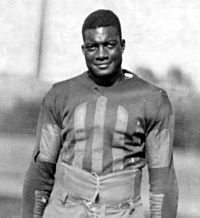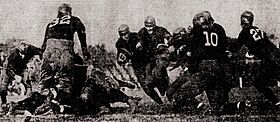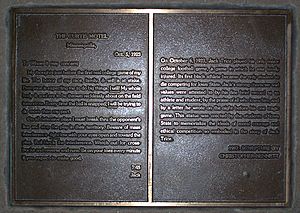Jack Trice facts for kids

Script error: The function "getImageLegend" does not exist.
|
|
| No. 37 | |
|---|---|
| Position | Tackle |
| Major | Animal husbandry |
| Personal information | |
| Born: | May 12, 1902 Hiram, Ohio, U.S. |
| Died: | October 8, 1923 (aged 21) Ames, Iowa, U.S. |
| Height | 6 ft 0 in (1.83 m) |
| Weight | 215 lb (98 kg) |
| Career history | |
| College | Iowa State (1922–1923) |
| High school | East Technical |
John G. Trice (born May 12, 1902 – died October 8, 1923) was a talented American college football player. He made history as the first African-American athlete to play for Iowa State College. Jack Trice sadly passed away from injuries he received during a football game against the University of Minnesota on October 6, 1923. Today, Iowa State's football stadium, Jack Trice Stadium, is named in his honor.
Contents
Jack Trice's Early Life and College Years
Jack Trice was born in Hiram, Ohio, in 1902. His father, Green Trice, was a former soldier. From a young age, Jack loved sports and showed great athletic talent. In 1918, Jack moved to Cleveland to live with his uncle. He went to East Technical High School, where he played football. In 1922, Jack followed his high school coach, Sam Willaman, and some of his teammates to Iowa State College in Ames, Iowa.
While at Iowa State, Jack played football as a tackle and also ran track. On October 5, 1923, the night before his second college football game, Jack wrote a letter. He was staying in a hotel in Minneapolis/St. Paul that separated people based on their race. This letter was later found in his suit after he passed away.
My thoughts just before the first real college game of my life: The honor of my race, family & self is at stake. Everyone is expecting me to do big things. I will! My whole body and soul are to be thrown recklessly about the field tomorrow. Every time the ball is snapped, I will be trying to do more than my part. On all defensive plays I must break through the opponents' line and stop the play in their territory. Beware of mass interference. Fight low, with your eyes open and toward the play. Watch out for crossbucks and reverse end runs. Be on your toes every minute if you expect to make good. Jack.
The Game and Jack Trice's Passing
On October 6, 1923, Jack Trice and his Iowa State College team played against the University of Minnesota in Minneapolis. Jack was able to stay at the same hotel as his teammates that night. However, he could not eat with them in the dining room.
During the third part of the game, Jack was trying to tackle a Minnesota player. He fell on his back after a type of tackle that is no longer allowed today. He was accidentally stepped on by three Minnesota players. Jack said he was fine, but he could not stand up. He was taken out of the game and sent to a hospital in Minneapolis. The doctors said he was okay to travel, so he returned to Ames by train with his teammates. On October 8, 1923, Jack Trice died from serious internal injuries he received during the game.
There were many questions about what happened during the play that led to Jack's death.
To honor Jack, Iowa State canceled all classes after 3 p.m. on October 9, 1923.
Jack's funeral was held at Iowa State College's Central Campus in Ames on October 16, 1923. Jack was buried in Hiram, Ohio.
Jack Trice's Lasting Legacy
In 1973, people started working to name Iowa State's new football stadium after Jack Trice. In 1974, the students' government at Iowa State University voted to support this idea. A special committee also gathered more than 3,000 signatures from people who agreed. However, another committee suggested naming the stadium "Cyclone Stadium."
In 1984, the stadium was named Cyclone Stadium, and the playing field inside was named "Jack Trice Field." The students' government wanted to do more to honor Jack. They raised money to build a statue of him in 1987. Because of the hard work of students, alumni, teachers, staff, and other supporters (including famous people like Paul Newman and Nikki Giovanni), the football stadium at Iowa State University was finally named Jack Trice Stadium in 1997.
Today, the Iowa State football team, led by coach Matt Campbell, continues to honor Jack's memory. The team uses a special logo that looks like the uniforms from Jack's time. They have also added the words "I will!" (in Jack's own handwriting) to their helmets.
Some people believe Jack Trice invented a special football play called the "shovel pass." This play was not used much after his time but became popular again later.
In 2023, Jack Trice was honored with a special butter sculpture at the Iowa State Fair. He was featured alongside other famous Iowa athletes like Caitlin Clark and Kurt Warner.
Also in 2023, on the 100th anniversary of his death, Iowa State held many events to remember Jack. They had exhibitions and lectures. They renamed the street in front of the stadium to Jack Trice Way. A new sculpture called "Breaking Barriers" by artist Ivan Toth Depeña was also unveiled. A special Jack Trice Legacy football game was played. Finally, Jack's family accepted a special college degree for him in animal husbandry.
Interesting facts about Jack Trice
- At college, Jack studied animal husbandry, hoping to use his knowledge to help farmers in the South.
- Before starting his first year of college, Jack married Cora Mae Starland. They both worked hard to help pay for their studies.
- Jack was part of a college club called Alpha Phi Alpha.
- Because of Jack's death, Iowa State stopped playing against Minnesota for 66 years. The teams did not play each other again until 1989.
- About 4,000 students and teachers attended his funeral. His casket was covered in Iowa State's school colors, cardinal and gold.
- Jack Trice Stadium is the only major college football stadium named after an African-American athlete.
- Jack's story has been told in a successful play that started in 2010. There have also been talks about making a movie about his life.
See Also
- Johnny Bright incident, another important event involving a college athlete from Iowa.



